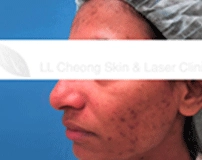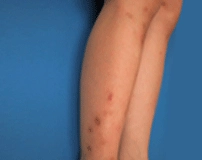



When the skin is in the process of recovering from an injury, whether the result of an accident, surgery, a burn, or acne, scarring will occur wherever multiple layers of the skin have been affected. Once a scar forms, it is permanent but may be made less visible.
The most basic requirement for all treatment is good health. Other requirements are subtler and should be
carefully considered in discussion with your skin specialist.
Expectations of the treatment and of the dermatologist must be realistic. A person considering facial scar
treatment must understand that there is no way to remove scars completely. The goal is to improve the appearance
of the scar either by disguising it, relocating it, or minimizing its prominence. Skin color and type, age, and
the type of scarring, are all important factors that must be part of the discussion prior to
treatment.
Different scars require different treatments. For example, severe burns that destroy large
sections of skin cause the skin to heal in a puckered way. As the skin heals, muscles and tendons may be
affected in this "contracting" movement.
Keloid scars are a result of the skin's overproduction of collagen after a wound has healed. These
scars generally appear as growths in the scar site. Hypertrophic scars, unlike keloids, do not grow out of the
boundaries of the scar area, but because of their thick, raised texture, can be unsightly and may also restrict
the natural movement of muscle and tendons.
Because scars are highly individualistic and the patient's
attitude toward scars is so personal, maximum improvement in facial scars may require more than one procedure,
and more than one technique may be employed.
Dermabrasion and laser resurfacing are methods a surgeon
uses to make "rough or elevated" scars less prominent, by removing part of the upper layers of skin with an
abrading tool or laser light. Clearly, the scar will remain, but it will be smoother and less
visible.
Keloid or hypertrophic scars are often treated first with injections of steroids to reduce size.
If this is not satisfactory, the scars can be removed surgically, and the incisions closed with fine stitches,
often resulting in less prominent scars.

Pigmented Acne Scars

Pigmented Scars on Legs